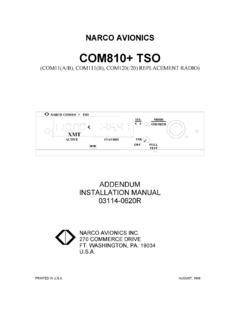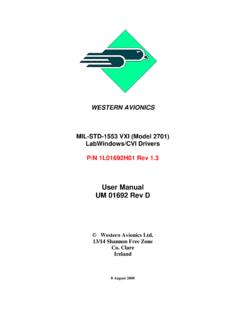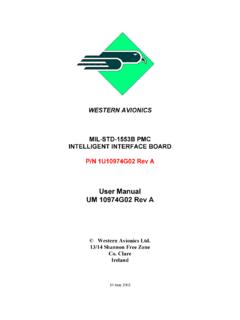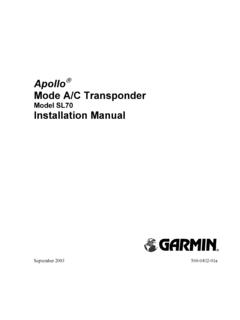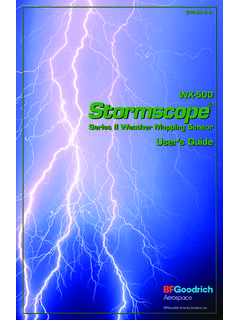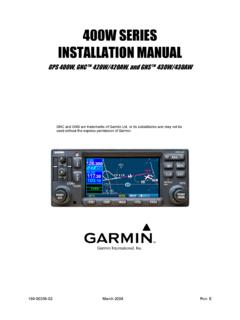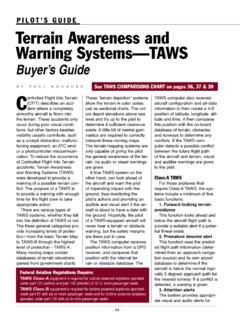Transcription of Traffic Alert/Advisory System - Integrated Avionics
1 $ $ s Guidefor thePilot s Guidefor theTraffic Alert/Advisory SystemModel SKY899 Traffic Alert/Advisory SystemModel SKY899 SKY899 Pilot s GuideAEyes That Never Blink Early Traffic Alert/Advisory SystemsIn the early days of flight, pilots were equipped with all theyneeded for effective collision avoidance a sharp pair of increasing Traffic at higher speeds led to the developmentof TCAS I and II ( Traffic alert and Collision Avoidance Systems)which were too expensive for most regional airlines, businessaircraft, and general aviation Goodrich Avionics Systems, Inc. recognized the need for analternative to expensive TCAS systems and developed theSKYWATCH model SKY497 Traffic advisory System (TAS) andthe SKYWATCH HP model SKY899 TAS/TCAS SKYWATCH HP can be installed as a TAS to provide mostof the capabilities of TCAS I, but at a significantly lower cost,making it practical for small aircraft.
2 The SKYWATCH HP canalso be installed as a TCAS addition to its TCAS I capability, SKYWATCH HP improvesupon the SKY497 by adding a larger display range (15 nmi), ahigher maximum closure rate (1200 kn), and built-in hardwareand software that makes the SKYWATCH HP AutomaticDependent Surveillance-Broadcast (ADS-B)-ready for the futurewhen the technology becomes ExperienceGoodrich Avionics Systems, Inc. has been involved in thedevelopment of collision warning programs since the early1980 s. In 1985, Goodrich Avionics Systems began developmentof an enhanced collision warning System for the Navy s T-34 Ctraining largely on the success of the Navy project, GoodrichAvionics Systems was selected to validate the specifications forTCAS I.
3 As a result, Goodrich Avionics Systems original TCAS Iunit, the TCAS791 was the first TCAS I to be granted a TechnicalStandard Order (TSO), first to receive a full, unrestricted Supple-mental Type Certificate (STC), first to fly, and first to be delivered.$ s Guidefor theTraffic Alert/Advisory SystemModel SKY899 Copyright 2001 Goodrich Avionics Systems, , EYES THAT NEVER BLINK , and stormscope are trademarks ofGoodrich Avionics Systems, GOODRICH & Stripes Design Logo is a trademark of Goodrich and manufactured in the United States of America byMethods and apparatus disclosed and described herein have been developed solely on company funds of GoodrichAvionics Systems, Inc.
4 No government or other contractual support or relationship whatsoever has existedwhich in any way affects or mitigates proprietary rights of Goodrich Avionics Systems, Inc. in these develop-ments. Methods and apparatus disclosed herein may be subject to Patents existing or applied for. GoodrichAvionics Systems, Inc. reserves the right to add, improve, modify, or withdraw functions, design modifica-tions, or products at any time without Avionics Systems, 52nd Street, Rapids, MI 49512 USA(800)253-9525 or (616)949-6600 Fax (616) SKY899 Pilot s GuideiiSafety SummaryThese warnings and cautions appear later in this guide and arerepeated here for emphasis:To avoid power surges that could damage the SKY899 and theoptional WX-1000, start your engines before turning on the the SKY899 is in SKYWATCH mode, the display will not auto-matically switch into stormscope mode to display thunderstorms orStormscope errors.
5 Use the remote SKYWATCH/ stormscope modeswitch to periodically check for thunderstorms or stormscope SKY899 relies on information obtained from transponders innearby aircraft. The SKY899 does not detect or track aircraft whichare not equipped with an operating Air Traffic Control RadarBeacon System (ATCRBS) SKY899 does not track intruder aircraft approaching at aclosure rate greater than 1200 Traffic within the chosen display range may not be displayeddue to Traffic prioritizing, antenna shielding, or ground SKY899 performance is realized when intruder aircraftare reporting their altitude (via a mode C or other altitudereporting transponder).Do not attempt evasive maneuvers based solely on Traffic informa-tion on the display.
6 Information on the display is provided to theflight crew as an aid in visually acquiring Traffic ; it is not areplacement for Air Traffic Control (ATC) and See & 3-5page 3-6page 3-6page 3-6page 3-6 CAUTION page 3-1page 3-6 WARNINGWARNINGWARNINGWARNINGWARNING SKY899 Pilot s GuideiiiTable of ContentsSectionPageList of vList of & viiChapter 1, System 1-1 General 1-1 Transmitter Receiver Computer (TRC).. 1-2 Directional 1-3 Interaction of Major 1-4 Functional 1-6 Chapter 2, Controls & 2-1 Controls, Indicators, & 2-1 Controls Required for the stormscope 2-5 Controls & Indicators for an Alternate 2-6 Aural 2-6 Chapter 3, Operating 3-1 Turn On the 3-1 Run the Operator-Initiated Self 3-3 Switch Between Standby & Operating 3-3 Change the Display 3-4 Change the Vertical Display 3-5 Switch Between SKYWATCH & the 3-6 Respond to Traffic 3-6 Turn Off the SKY899 and the Optional 3-7 Operate the WX-1000 Without the 3-7 Operate the SKY899 Without the 3-7 Message 3-7 Respond to a Failed 3-7 Respond to a Degraded 3-8 SKY899 Pilot s GuideivSectionPageTable of Contents (continued)
7 Chapter 4, Principles of 4-1 Sensitivity 4-1 Sensitivity Level 4-1 Sensitivity Level 4-3 Audio Inhibit, 4-5 Audio Inhibit, GPWS, EGPWS, or 4-5TA Symbol 4-6 Ground Intruder 4-6 Chapter 5, Display 5-1 Chapter 6, 6-1 Chapter 7, Warranty 7-1 Warranty 7-1 Related Policies and 7-2 SKY899 Pilot s GuidevList of IllustrationsFigureTitlePage1-1 SKY899 Major 1-11-2 Display with Typical SKYWATCH HP 1-31-3 Display with Typical stormscope Screen (Optional).. 1-31-4 System Block 1-51-5 Vertical Display Modes and Traffic 1-72-1 Controls & Screen Elements in 2-12-2 Controls & Screen Elements in Operating 2-22-3 Vertical Display Mode Indicator 2-63-1 Goodrich 3-13-2 Standby 3-23-3In-Flight Traffic 3-23-4 Failed 3-23-5 Test 3-33-6 Traffic Screen on the 3-43-7 Display 3-43-8 Message Screen with Two 3-93-9 Message Screen with No 3-94-1TA Zones If Your Aircraft Has a Radio 4-44-2TA Zones If Your Aircraft Has No Radio Altimeter, But Does Have aRetractable Landing 4-44-3TA Zones If Your Aircraft Has No Radio Altimeterand a Fixed Landing 4-65-1TA & OT on 15 nmi Range.
8 UNR 5-15-2 Other Traffic on 15 nmi Range, UNR 5-25-3 Other Traffic on 6 nmi Range, NRM 5-25-4TA & OT on 2 nmi Range, BLW Mode .. 5-25-5 Off-Screen TA on 2 nmi Range, ABV 5-35-6 Standby 5-35-7 Failed 5-3 SKY899 Pilot s Guidevi4-1 Fourteen Situations in Which a Traffic advisory Will 4-26-1 TRC899 6-16-2WX-1000/SKY497 Display 6-36-3NY164 Directional Antenna Specifications(for TAS installations only).. 6-46-4NY156 Directional Antenna Specifications(required for TCAS I installations, optional for TAS) .. 6-4 TableTitlePageList of Tables SKY899 Pilot s GuideviiAbbreviations & AcronymsABVA boveAckAcknowledgeADS-BAutomatic Dependent Surveillance-BroadcastAFSF light Standards ServiceAGLA bove Ground LevelAHRSA ttitude and Heading Reference SystemAltAltitudeARINCA eronautical Radio.
9 Traffic ControlATCRBSAir Traffic Control Radar Beacon SystemATIAir Transport IndicatorATMAir Traffic ManagementBLWB elowCommCommunicationCPAC losest Point of ApproachCRTC athode Ray TubeEFISE lectronic Flight Instrument SystemEGPWSE nhanced Ground Proximity Warning SystemFAAF ederal Aviation AdministrationfpmFeet Per MinuteFSAWF light Standards Information Bulletin forAirworthinessGPSG lobal Positioning SystemGPWSG round Proximity Warning SystemGrndGroundHPHigh PerformanceI/OInput/OutputIVSII nstantaneous Vertical Speed IndicatorknKnotsMFDM ulti-Function DisplayModModificationMSGM essageNavNavigationnmNautical Miles (on the display) SKY899 Pilot s GuideviiiAbbreviations & Acronyms (continued)nmiNautical Miles (in the text)
10 NRMN ormalOPRO perateOTOther TrafficPAProximity AdvisoryP/NPart NumberRevRevisionRGCR adar Graphics ComputerRTCAR equirements & Technical Concepts for AviationSLAS ensitivity Level ASLBS ensitivity Level BSSRS econdary Surveillance RadarSTBS tandbySTCS upplemental Type CertificateTATraffic AdvisoryTAST raffic advisory SystemTAWST errain Awareness and Warning SystemTCAST raffic alert and Collision Avoidance SystemTRCT ransmitter Receiver ComputerTSOT echnical Standard OrderUNRU nrestricted SKY899 Pilot s Guide1-1 System DescriptionChapter 1 General DescriptionThe SKYWATCH HP Traffic Alert/Advisory System , modelSKY899, from Goodrich Avionics Systems, Inc. can be installedas a Traffic alert and Collision Avoidance System I (TCAS I) oras a Traffic advisory System (TAS).


